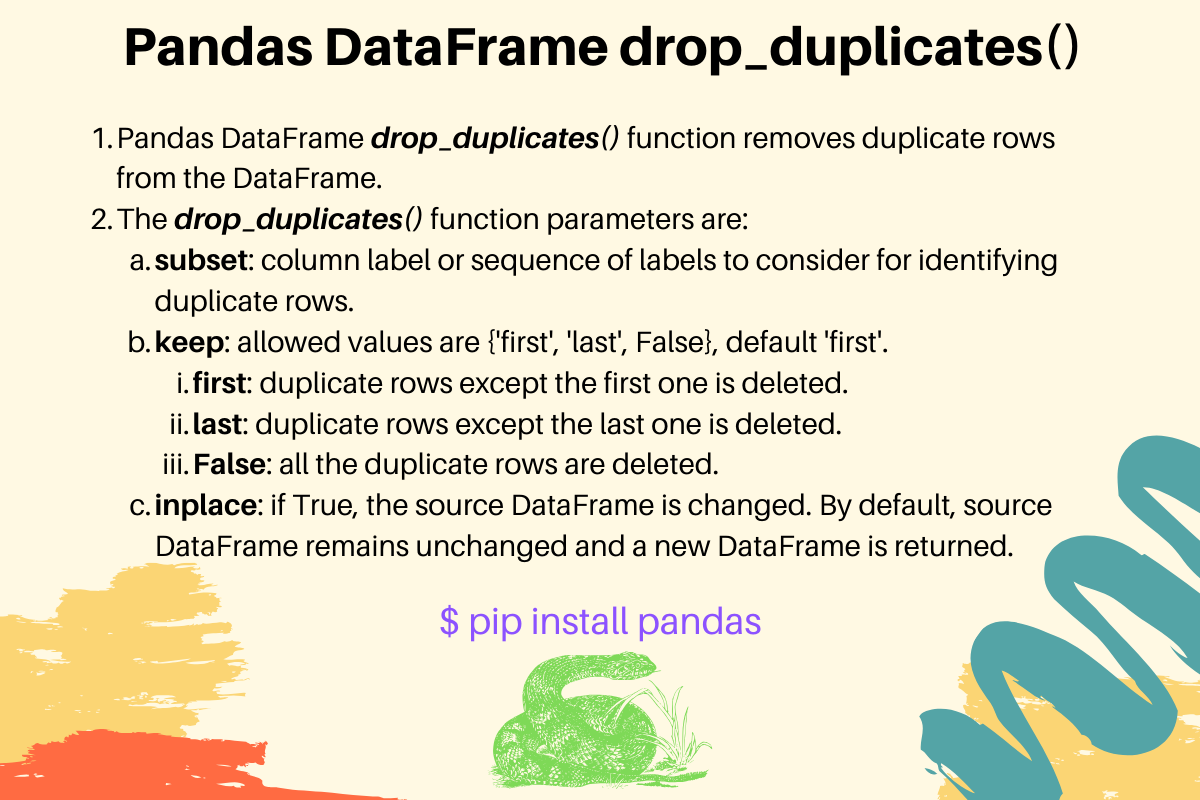- Log in to:
- Community
- DigitalOcean
- Sign up for:
- Community
- DigitalOcean
By Pankaj Kumar

Pandas drop_duplicates() Function Syntax
Pandas drop_duplicates() function removes duplicate rows from the DataFrame. Its syntax is:
drop_duplicates(self, subset=None, keep="first", inplace=False)
- subset: column label or sequence of labels to consider for identifying duplicate rows. By default, all the columns are used to find the duplicate rows.
- keep: allowed values are {‘first’, ‘last’, False}, default ‘first’. If ‘first’, duplicate rows except the first one is deleted. If ‘last’, duplicate rows except the last one is deleted. If False, all the duplicate rows are deleted.
- inplace: if True, the source DataFrame is changed and None is returned. By default, source DataFrame remains unchanged and a new DataFrame instance is returned.
Pandas Drop Duplicate Rows Examples
Let’s look into some examples of dropping duplicate rows from a DataFrame object.
1. Drop Duplicate Rows Keeping the First One
This is the default behavior when no arguments are passed.
import pandas as pd
d1 = {'A': [1, 1, 1, 2], 'B': [2, 2, 2, 3], 'C': [3, 3, 4, 5]}
source_df = pd.DataFrame(d1)
print('Source DataFrame:\n', source_df)
# keep first duplicate row
result_df = source_df.drop_duplicates()
print('Result DataFrame:\n', result_df)
Output:
Source DataFrame:
A B C
0 1 2 3
1 1 2 3
2 1 2 4
3 2 3 5
Result DataFrame:
A B C
0 1 2 3
2 1 2 4
3 2 3 5
The source DataFrame rows 0 and 1 are duplicates. The first occurrence is kept and the rest of the duplicates are deleted.
2. Drop Duplicates and Keep Last Row
result_df = source_df.drop_duplicates(keep='last')
print('Result DataFrame:\n', result_df)
Output:
Result DataFrame:
A B C
1 1 2 3
2 1 2 4
3 2 3 5
The index ‘0’ is deleted and the last duplicate row ‘1’ is kept in the output.
3. Delete All Duplicate Rows from DataFrame
result_df = source_df.drop_duplicates(keep=False)
print('Result DataFrame:\n', result_df)
Output:
Result DataFrame:
A B C
2 1 2 4
3 2 3 5
Both the duplicate rows ‘0’ and ‘1’ are dropped from the result DataFrame.
4. Identify Duplicate Rows based on Specific Columns
import pandas as pd
d1 = {'A': [1, 1, 1, 2], 'B': [2, 2, 2, 3], 'C': [3, 3, 4, 5]}
source_df = pd.DataFrame(d1)
print('Source DataFrame:\n', source_df)
result_df = source_df.drop_duplicates(subset=['A', 'B'])
print('Result DataFrame:\n', result_df)
Output:
Source DataFrame:
A B C
0 1 2 3
1 1 2 3
2 1 2 4
3 2 3 5
Result DataFrame:
A B C
0 1 2 3
3 2 3 5
The columns ‘A’ and ‘B’ are used to identify duplicate rows. Hence, rows 0, 1, and 2 are duplicates. So, rows 1 and 2 are removed from the output.
5. Remove Duplicate Rows in place
source_df.drop_duplicates(inplace=True)
print(source_df)
Output:
A B C
0 1 2 3
2 1 2 4
3 2 3 5
Thanks for learning with the DigitalOcean Community. Check out our offerings for compute, storage, networking, and managed databases.
About the author
Java and Python Developer for 20+ years, Open Source Enthusiast, Founder of https://www.askpython.com/, https://www.linuxfordevices.com/, and JournalDev.com (acquired by DigitalOcean). Passionate about writing technical articles and sharing knowledge with others. Love Java, Python, Unix and related technologies. Follow my X @PankajWebDev
Still looking for an answer?
- Table of contents
- Pandas drop\_duplicates() Function Syntax
- Pandas Drop Duplicate Rows Examples
- References
Deploy on DigitalOcean
Click below to sign up for DigitalOcean's virtual machines, Databases, and AIML products.
Become a contributor for community
Get paid to write technical tutorials and select a tech-focused charity to receive a matching donation.
DigitalOcean Documentation
Full documentation for every DigitalOcean product.
Resources for startups and SMBs
The Wave has everything you need to know about building a business, from raising funding to marketing your product.
Get our newsletter
Stay up to date by signing up for DigitalOcean’s Infrastructure as a Newsletter.
New accounts only. By submitting your email you agree to our Privacy Policy
The developer cloud
Scale up as you grow — whether you're running one virtual machine or ten thousand.
Get started for free
Sign up and get $200 in credit for your first 60 days with DigitalOcean.*
*This promotional offer applies to new accounts only.
